Do you feel your children
are adrift?
The Naval Sea Cadet program may be the answer!
By Wayne Spivak
National Press Corps
United States Coast Guard Auxiliary
Do your children seem to be lost,
and without direction? Are they have trouble focusing; in school,
and at home? Do they have too much free time and energy, without
a meaningful place and rewarding place to funnel their energy?
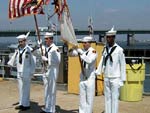 While most
of our communities provide many excellent programs for young
adults, many programs are limited. Some are only for males,
while others for females. Few are truly co-ed. However, one
program you should look into is the Naval Sea Cadet program.
While most
of our communities provide many excellent programs for young
adults, many programs are limited. Some are only for males,
while others for females. Few are truly co-ed. However, one
program you should look into is the Naval Sea Cadet program.
This unique program is actually
a combination of two different entities, both run by the same
parent organization. The first program is the United States
Naval Sea Cadets Corps (NSCC) for those 13 to 17 years of age.
This federally chartered organization is administered by the
Navy League of the United States. The second program for the
younger set, is called the Navy League Cadet Corps (NLCC). This
program is for those aged 11 to 13.
Both programs have similar goals;
to develop an interest in the skills of seamanship, the virtues
of good citizenship, and morals. These virtues include avoidance
of alcohol, drug, and gang related cultures. The final value
set is based upon those used by the military; honor, respect
and duty.
History of the Sea Cadets
Originally, the Sea Cadets was the
idea of the Navy Department. Since the Navy was unable to actually
run the program, they turned to the Navy League who founded
the Naval Sea Cadet Corps in 1958 to "create a favorable image
of the navy on the part of American youth." In 1962, Congress
federally charted the program. In 1968, the Navy League approached
the Coast Guard to become a co-sponsor with the Navy, which
began officially in 1969. Since that time (now almost 34 years)
both military organizations have hosted the NSCC.
 The NSCC
is based on a local unit (called a Division) philosophy, where
training ("drills") are conducted. Entering Sea Cadets are sent
to either the Navy's Recruit Training Command or a regional
recruit training site for a two-week "mini" boot camp. Here,
the Cadet learns about military life, discipline, naval history,
core personal values, water safety, and begins to build an esprit
de corps, which in turn, begins to help the Cadet to focus.
The NSCC
is based on a local unit (called a Division) philosophy, where
training ("drills") are conducted. Entering Sea Cadets are sent
to either the Navy's Recruit Training Command or a regional
recruit training site for a two-week "mini" boot camp. Here,
the Cadet learns about military life, discipline, naval history,
core personal values, water safety, and begins to build an esprit
de corps, which in turn, begins to help the Cadet to focus.
Training Opportunities
Cadets are led by a Corps of adults
that are recruited from both civilian, and military (active
duty, reserve, retired or other military) life. These adults
pass a background check and they themselves are required to
attend several basic, intermediate and advanced Officer Professional
Development courses. While both the adults and Cadets wear Navy-like
uniforms, and hold naval-like military titles, they are not
part of the military, and receive no pay or allowances. However,
both adult and Cadet, while in or out of uniform, required to
observe military courtesy (and while in uniform receive said
courtesy) and the values inherent in the program.
Training received by Cadets can
take many forms, since both the Navy and Coast Guard have large
number of missions, and training opportunities. These opportunities
include training at Navy or Coast Guard facilities, and on assets
of the respective services. Assets, in military jargon includes
ships, small boats, and aircraft; depending on availability.
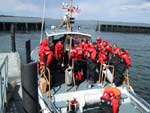 "The Coast
Guard offers the best platform for both learning and doing in
the NSCC," says CAPT Michael D. Ford, USNR (Ret.) the Executive
Director of NSCC. The reason for this is that "the Coast Guard
vessels are usually small, and active. The Cadets get to handle
lines, plot courses, and work side by side with the Coasties."
"The Coast
Guard offers the best platform for both learning and doing in
the NSCC," says CAPT Michael D. Ford, USNR (Ret.) the Executive
Director of NSCC. The reason for this is that "the Coast Guard
vessels are usually small, and active. The Cadets get to handle
lines, plot courses, and work side by side with the Coasties."
"Naval ships are usually much larger",
explained CAPT Ford, "and thus while more exciting, the hands-on
potential for the Cadets is also more limited." In either case,
whether the NSCC unit is located with the Coast Guard, the Navy,
at a sea base or a land base, "the NSCC offers a lifestyle that
is beneficial to all Cadets."
As a Cadet grows with the program,
more and more training opportunities become available. And what's
nice about this program, is that most of the costs associated
with training are borne either by federal funding or other grant
funds. Some of the advanced training courses provided in 2001
and 2002 include: Rescue Swimmer Classes at NAS Pensacola, FL,
Amphibious Operations training at the Naval Amphibious Base
in Little Creek, VA, SEAL Orientation, sailing classes, working
slots on over 400 Coast Guard Cutters, Bases and Stations.
Life in the NSCC
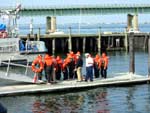 I recently
paid a visit to the Liberty (AGTR-5) Division (https://www.libertyagtr5div.org/), located
at Coast Guard Station Fire Island, just a mile or so from the
famous Fire Island Lighthouse, Babylon, Long Island, NY. There
I watched as the Cadet Company go through a training rotation.
I recently
paid a visit to the Liberty (AGTR-5) Division (https://www.libertyagtr5div.org/), located
at Coast Guard Station Fire Island, just a mile or so from the
famous Fire Island Lighthouse, Babylon, Long Island, NY. There
I watched as the Cadet Company go through a training rotation.
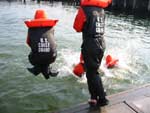 Fire Island
Coast Guard Station has a broad based complement of boats, from
small 20' RHIB (Rigid Hull Inflatable Boat) to a 47' Motor Life
Boat. For those who have seen pictures of the Coast Guard vessel
flying through rough surf, this is the vessel shown. Its most
unique characteristic is that it's self righting. In other words,
should it overturn, the vessel will turn right-side up again
in 8 seconds).
Fire Island
Coast Guard Station has a broad based complement of boats, from
small 20' RHIB (Rigid Hull Inflatable Boat) to a 47' Motor Life
Boat. For those who have seen pictures of the Coast Guard vessel
flying through rough surf, this is the vessel shown. Its most
unique characteristic is that it's self righting. In other words,
should it overturn, the vessel will turn right-side up again
in 8 seconds).
This morning, the Cadet Corps was
learning what it is like to don, use 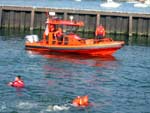 and float
in Survival Suits. Each Cadet was required to put on a Coast
Guard Survival Suit, jump into the water (it was 58 degrees),
and swim approximately 300 yards. According to LT Americo (Rick)
Aimetti, NSCC, "...the reason for this particular training event
was to familiarize the Cadets with what its like, in the cold
water, should they be thrown overboard during a mission on a
Coast Guard Vessel. In addition, they needed to feel safe, comfortable
in both the knowledge that they could put one on, and that the
Survival Suit will help them keep warm and most importantly,
float!"
and float
in Survival Suits. Each Cadet was required to put on a Coast
Guard Survival Suit, jump into the water (it was 58 degrees),
and swim approximately 300 yards. According to LT Americo (Rick)
Aimetti, NSCC, "...the reason for this particular training event
was to familiarize the Cadets with what its like, in the cold
water, should they be thrown overboard during a mission on a
Coast Guard Vessel. In addition, they needed to feel safe, comfortable
in both the knowledge that they could put one on, and that the
Survival Suit will help them keep warm and most importantly,
float!"
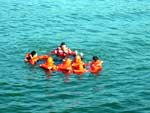 During this
training evolution, these young men and women were under the
close eye of two Coast Guard swimmers, who were in the water,
and a RHIB; standing by 10 feet away. On dry dock, were another
six pairs of eyes, those of the NSCC Adult leaders. As we stood
on the wharf, we heard shouts of laughter, and other noises
of glee that you would hear at any swimming pool where children
played. But you also heard educational statements made, such
as "gee, my feet are frozen", or "wow, I can just lie here and
float."
During this
training evolution, these young men and women were under the
close eye of two Coast Guard swimmers, who were in the water,
and a RHIB; standing by 10 feet away. On dry dock, were another
six pairs of eyes, those of the NSCC Adult leaders. As we stood
on the wharf, we heard shouts of laughter, and other noises
of glee that you would hear at any swimming pool where children
played. But you also heard educational statements made, such
as "gee, my feet are frozen", or "wow, I can just lie here and
float."
Leadership by Example
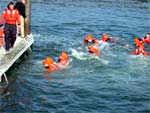 The
adult leaders of this particular NSCC Division lead by example.
And, according to the United States Naval Sea Cadet Corps and
the Commanding Officer of Coast Guard Group Moriches, they distinguished
themselves on Sunday, August 2nd, 2002. On this day, Coast Guard
Day, while working with the Sea Cadets, LT Aimetti and LTjg
Dante Laurino helped save the life a member of the United States
Coast Guard.
The
adult leaders of this particular NSCC Division lead by example.
And, according to the United States Naval Sea Cadet Corps and
the Commanding Officer of Coast Guard Group Moriches, they distinguished
themselves on Sunday, August 2nd, 2002. On this day, Coast Guard
Day, while working with the Sea Cadets, LT Aimetti and LTjg
Dante Laurino helped save the life a member of the United States
Coast Guard.
Do to their quick actions, they
prevented a Coast Guard Petty Officer from further injury as
well as maintained an open airway to insure that the Petty Officer
could breathe. In appreciation of the quick actions, they were
both awarded the Distinguished Service Ribbon, as well as a
Letter of Appreciation from the Coast Guard.
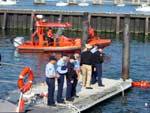 What is
unique about LT Aimetti and LTjg Laurino, as well as most of
the other adult leaders of this Division, are that they also
members of the United States Coast Guard Auxiliary.
What is
unique about LT Aimetti and LTjg Laurino, as well as most of
the other adult leaders of this Division, are that they also
members of the United States Coast Guard Auxiliary.
Leadership by example, Inculcation
of values, and Education: This is what the US Naval Sea Cadet
Program is all about.
Scholarships and Awards
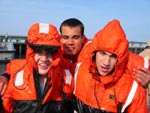 All Cadets
are eligible to apply for scholarships to help defray the costs
of their college education. In 2001, 149 scholarships were awarded
and in 2002, a total of 162 different scholarships were awarded.
In 2001, $160,000 went toward higher education, while in 2002
$175,800 was provided.
All Cadets
are eligible to apply for scholarships to help defray the costs
of their college education. In 2001, 149 scholarships were awarded
and in 2002, a total of 162 different scholarships were awarded.
In 2001, $160,000 went toward higher education, while in 2002
$175,800 was provided.
The NSCC is dedicated to providing
the structure and the focus for their Cadets to compete in both
academia, as well as the workplace. The discipline learned in
the Corps enables the student to adhere to the dictates of proper
work-study habits, which help to increases their grades, and
their success.
Cadets are also able to win awards
for personal and unit excellence. These awards both highlight
and commend superior performance and leadership, but provide
a litmus test within the local units, as well as the Corps for
what traits make a successful Cadet, and citizen. Some awards
come with monetary grants, others with plaques and ribbons.
Regardless of whether the Cadet
gets a check, a ribbon, a medal or a certificate, they have
received a public "that-a-boy/girl" for obtaining a higher level
of achievement. For many, it is their first time being told
how well they have performed, in such a public manner. For all,
it's a badge of honor.
Like the Boy Scouts and Sea Scouts,
there is one position which is the pinnacle of achievement in
the Sea Cadets. The Boy Scouts have Eagle Scout., The Sea Scouts
have Quartermaster, and the NSCC has Chief Petty Officer. In
2002, there were only 55 Naval Sea Cadets promoted to Chief
Petty Officer. For it was their commitment to the program; the
average of 64 days of training, as well as passing of a series
of tests; which clearly placed these young men and women among
the crème de la crème of the Naval Sea Cadet Corps.
Life after the NSCC
A life of service doesn't end for
many Cadets, after their 17th birthday. For some, they apply
and receive acceptance to one of the military academies, for
others its Officer Candidate School after graduating from college.
While for others there is enlistment in one of the services,
or joining the Coast Guard Auxiliary.
In 2002, 575 Cadets were tracked
entering some service related institution. According to CAPT
Michael D. Ford, USNR (Ret.), "these figures are low, since
many Cadets leave the program prior to the 17th birthday, and
are no longer tracked by the Navy League." In any event, America's
Sea Services and America itself are better off, since those
who do join the service or continue on in civilian life, have
developed the skills to be a good citizen.
For more information about the Naval
Sea Cadet Corps or the Navy League Cadet Corps, you can contact
them at 703-243-6910 or at https://www.seacadets.org/. For more information
about the Navy see your local recruiter or find them at www.navy.mil.
For the Coast Guard, again see your local recruiter or go to
https://www.cgaux.org/, and the Coast Guard Auxiliary
can be found at https://www.cgaux.org/.


